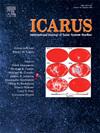The curious case of the missing mantle: How carbonaceous chondrites may confound the spectral identification of partially differentiated asteroids
IF 2.5
2区 物理与天体物理
Q2 ASTRONOMY & ASTROPHYSICS
引用次数: 0
Abstract
The scarcity of olivine-rich mantle material in meteorite collections and asteroid spectra, known as the “Missing Mantle Conundrum,” challenges our understanding of planetesimal differentiation. Current models suggest that numerous planetesimals underwent melting and differentiation early in Solar System history, yet little evidence of olivine- and pyroxene-rich mantles is found. We explore the hypothesis that mantle material may be present in the asteroid belt but is spectrally masked by dark, primitive carbonaceous chondrite material. To test this, we mixed laboratory analogs of CM and CV chondrite mantle compositions with natural CM2 and CV3 meteorites, examining how particle size and chondritic material abundance affect the detectability of diagnostic silicate absorption features. Visible-near infrared (VNIR) reflectance spectra demonstrate that even small amounts of carbonaceous material can suppress olivine and pyroxene absorption bands. The suppression of absorption features and spectral darkening is highly nonlinear, with this effect being most notable for the finer particles and the CM chondrites. At mantle abundances below 20 wt%, spectral features for all mixtures become virtually indistinguishable from those of the chondrite meteorites. Simulated noise levels typical of ground-based telescopic observations reveal that mantle material can be masked at even higher abundances, potentially obscuring ∼30–65 wt% of mantle material. These findings suggest that significant amounts of olivine- and pyroxene-rich mantle material may be present in near-Earth and main-belt asteroids, currently classified as primitive bodies. Rubble pile asteroids, which are widespread, may be particularly susceptible to misinterpretation due to their complex regolith, where differentiated mantle material can be mixed with primitive, undifferentiated components. This mixing, which arises naturally through the Solar System's ongoing collisional evolution, complicates spectral interpretations and highlights the potential for underestimating the extent of differentiation in these bodies.
求助全文
约1分钟内获得全文
求助全文
来源期刊

Icarus
地学天文-天文与天体物理
CiteScore
6.30
自引率
18.80%
发文量
356
审稿时长
2-4 weeks
期刊介绍:
Icarus is devoted to the publication of original contributions in the field of Solar System studies. Manuscripts reporting the results of new research - observational, experimental, or theoretical - concerning the astronomy, geology, meteorology, physics, chemistry, biology, and other scientific aspects of our Solar System or extrasolar systems are welcome. The journal generally does not publish papers devoted exclusively to the Sun, the Earth, celestial mechanics, meteoritics, or astrophysics. Icarus does not publish papers that provide "improved" versions of Bode''s law, or other numerical relations, without a sound physical basis. Icarus does not publish meeting announcements or general notices. Reviews, historical papers, and manuscripts describing spacecraft instrumentation may be considered, but only with prior approval of the editor. An entire issue of the journal is occasionally devoted to a single subject, usually arising from a conference on the same topic. The language of publication is English. American or British usage is accepted, but not a mixture of these.
 求助内容:
求助内容: 应助结果提醒方式:
应助结果提醒方式:


